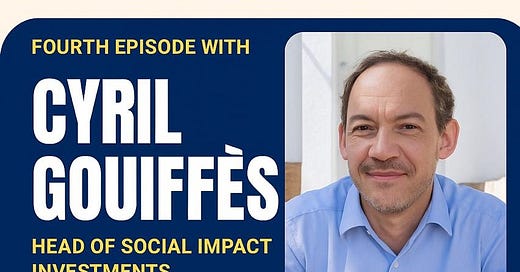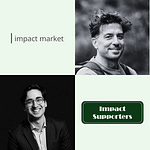Greetings to 3k+ Impact Supporters! 🌍 It’s August Solliv 👋 Today’s article and podcast are part of The Impact Highlight Series - a podcast series that I run with EUVC (Andreas Munk Holm) and ImpactVC/Better Society Capital (Douglas Sloan & Ellie Broad) where we are starting with 10 interviews with some of the most prolific impact investors in Europe. In this series, I don’t write a full article as you have been used to, but you get all the show notes from the interviewee below 🥳
Cyril unpacks what EIF looks for when backing emerging impact managers, why team dynamics matter more than ever, and how the market can defend against “impact washing” as the sector matures.
Agenda:
Why Cyril’s early influences shaped his mission-driven investing lens
From altruism to efficacy: lessons from failed NGO models
The rise of genuine dual-performance funds post-2014
Why team quality is the #1 differentiator in impact VC
EIF’s role in supporting first-time, emerging managers
Why impact metrics must tie to the business model
The dangers of forgetting your impact thesis post-fundraise
Impact failures vs. financial failures: lessons learned
Why LPs must stay engaged beyond the fundraising stage
State of fundraising: too many funds, not enough capital
The call for impact pioneers: back to the original thesis
A look at the person behind - who is Cyril Gouiffès?
…I have a background in political science, International relations, and Development economics
…A background that led me to start my career working for microfinance institutions in emerging markets (North Africa and the Middle East)
…I joined the EU institutions to work on microfinance projects in the EU in 2008, evolving into equity impact investments. My motivation is to also implement in ‘Northern’ economies financial innovation designed to alleviate poverty and promote social inclusion in ‘Southern’ economies.
The EIF has a history of being trailblazer as an LP in impact VCs. How has the market evolved in your time in the industry? What are the next trends that you will invest in?
The impact investing market has considerably matured in the last two decades, moving from USD 10bn managed by impact investors in 2014 to USD 220bn (source: the GIIN).
Impact AuM in 2014: USD 10bn Impact AuM in 2024: USD 220bn
This evolution is, first and foremost a good news, but also requires enhanced focus: more players in the ecosystem also mean more opportunistic behaviours. To sustain itself, impact investing requires genuine impact drive and genuine additionality.
This is one of many reasons why impact accountability and alignment across the value chain on both impact maximisation and financial performance lies at the heart of our investment strategy. EIF has been famous for implementing a mechanism whereby carried interest is subject to both financial performance and impact performance, and we keep on innovating on the mission alignment front.
How do you define a good impact fund today?
Additionality is what makes a great impact fund i.e. a fund that takes forward a strategy where impact is at the core, addressing thematics, sectors, and new frontiers, yielding powerful social / climate-related innovation where mainstream finance has not yet dared to venture.
Evaluation or monitoring of the quality of an investment has to stand on two legs: financial return and a clear, additional, scalable positive impact on society and the environment.
It should be stressed that beyond the mere portfolio creation, impact investing major contribution is the incorporation of both financial and impact KPIs to assess the quality of an investment before closing the investment (due diligence), during the holding (Advisory Committee role) and at realisation (finance alone is not enough, impact alone is not sustainable).
In your view, how do impact and returns interact? Can you share any data from the EIF’s extensive portfolio in this area?
Impact and returns have to be positively correlated.
We analyse from our portfolio that such correlation does prevail throughout our impact portfolio. Disclaimer: As in any portfolio approach, not 100% of our impact funds manage to secure this positive correlation.
Impact funds tend to take longer than ‘traditional funds’ to gain value traction, and the holding period before realisation tends to be longer. If time is of the essence here, it shall not be interpreted as a failure of impact funds to deliver a return.
Such time dynamics require impact fund managers and the impact value chain in general to think carefully about the appropriateness and fitness of financial instruments used. The overriding priority of impact investing shall be to maximise positive impact - period.
What are the learnings and challenges with the impact carry model that you can share with us?
The thesis behind impact carry is simple: for the sustainability of the impact investing market, impact has to be measured and tangible. Hence, it cannot simply be a reporting commitment, it has to be an incentive for the whole value chain, from entrepreneurs to GPs and their LPs.
Impact investing without measurement and accountability is merely impact washing.
Challenges characterizing impact carry are manyfold, however, one prevails: the variety of the market infrastructure in Europe to guarantee availability of knowledge, experts, legal framework is missing. Hence, the market in Europe is characterized by frontrunners who are gradually leading the way, The vision is to get to a sophisticated market infrastructure across the continent in the next 5 to 10 years.
How do we get more private LP money into impact VCs?
This is THE question, having in mind that public funding alone is not to be taken for granted and either way cannot do it alone.
First, increased innovation on the financial instrument itself has to take place: how to catalyze more private funding sources where the real capital is, using fewer public resources.
Second, podcasts such as this series play an important role: impact investing cannot afford to remain a cluster where impact investors talk to impact entrepreneurs. The word has to spread, and success stories have to hit the mainstream news in order to set precedents.
Strongly held belief you’ve recently had to change your mind on
Traditional business models will always outweigh impact business models in the VC deal flow.
DEI, green investments, and social innovation will never be hostage to politics and are a commonly accepted necessity across the globe.
What’s your best fundraising tip for impact VC investors?
Be yourself, don’t try to make up your identity to secure funding.
Be accountable for the impact you aim to achieve.
Never stop breaking glass ceilings and explore new frontier markets, sectors, and thematics
Never stop breaking glass ceilings and explore
Be humble: as ambitious as it should be, impact investing will never solve world problems alone.













Share this post